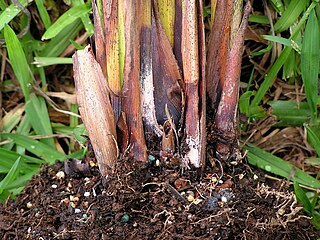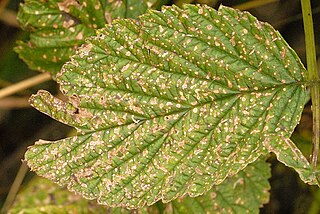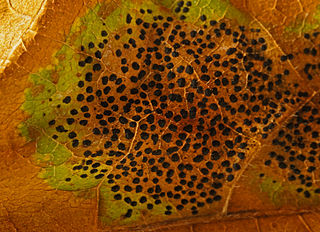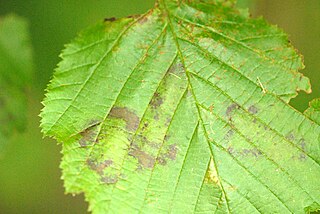
Spearmint, a species of mint (mentha) scientifically classified as Mentha spicata (,) also known as garden mint, common mint, lamb mint and mackerel mint, is native to Europe and southern temperate Asia, extending from Ireland in the west to southern China in the east. It is naturalized in many other temperate parts of the world, including northern and southern Africa, North America, and South America. It is used as a flavouring in food and herbal teas. The aromatic oil, called oil of spearmint, is also used as a flavoring and sometimes as a scent.

A leaf spot is a limited, discoloured, diseased area of a leaf that is caused by fungal, bacterial or viral plant diseases, or by injuries from nematodes, insects, environmental factors, toxicity or herbicides. These discoloured spots or lesions often have a centre of necrosis. Symptoms can overlap across causal agents, however differing signs and symptoms of certain pathogens can lead to the diagnosis of the type of leaf spot disease. Prolonged wet and humid conditions promote leaf spot disease and most pathogens are spread by wind, splashing rain or irrigation that carry the disease to other leaves.

Withania somnifera, known commonly as ashwagandha or winter cherry, is an evergreen shrub in the Solanaceae or nightshade family that grows in India, the Middle East, and parts of Africa. Several other species in the genus Withania are morphologically similar.

Cercospora is a genus of ascomycete fungi. Most species have no known sexual stage, and when the sexual stage is identified, it is in the genus Mycosphaerella. Most species of this genus cause plant diseases, and form leaf spots. It is a relatively well-studied genus of fungi, but there are countless species not yet described, and there is still much to learn about the best-known members of the genus.

Verticillium albo-atrum is a plant pathogen with many hosts.
Septoria dianthi is a fungal plant pathogen infecting carnations.
Fusicladium pisicola is a species of fungal plant pathogen affecting pea plants.
Pleosphaerulina sojicola is a plant pathogen commonly causing spotted decolouration on the leafs of soybeans.
Ascochyta asparagina is a fungal plant pathogen. It causes stem blight of asparagus, causing loss or death of branches.
Coniothyrium wernsdorffiae is a plant pathogen that causes brand canker on rose. It can also be hosted by raspberry and brambleberry plants.

Rhabdocline pseudotsugae is a fungal plant pathogen. The pathogen, along with Rhabdocline weirii causes Rhabdocline needlecast; R. weirii only affects Douglas-fir trees. The disease causes the needles of the tree to discolor and eventually fall from the tree. It was originally common to the Rocky Mountain states of the United States but has since spread to Europe. Infections usually start in the spring or early summer and can change the color of the foliage to a variety of hues. The fungus produces apothecia that are normally found on the underside of needles but they also occur on the topside as well.

Gliocladium vermoeseni is a plant pathogen. It is a disease of palm species.
Ascospora ruborum is a species of anamorphic ascomycete fungus. It is a plant pathogen that causes cane spot and dieback of raspberry and dewberry.

Myriangiales is an order of sac fungi, consisting of mostly plant pathogens.

Phlox nivalis is a species of flowering plant in the Polemoniaceae family, it is commonly known as the trailing phlox, but other common names include Pineland phlox, Pine phlox, and sweet trailing. It is native to the southeastern states, along with Texas, Utah, and Michigan.

The Corticiales are an order of fungi in the class Agaricomycetes. The order is composed of corticioid fungi. Species within the order are generally saprotrophic, most of them wood-rotters, but several are parasitic on grasses or lichens. Plant pathogens of economic importance include Erythricium salmonicolor, Laetisaria fuciformis, Waitea circinata, Waitea oryzae, and Waitea zeae.
Raspberry leaf spot is a plant disease caused by Sphaerulina rubi, an ascomycete fungus. Early symptoms of infection are dark green spots on young leaves. As the disease progresses, these spots turn tan or gray in color. Disease management strategies for raspberry leaf spots include the use of genetically resistant raspberry plant varieties, chemical fungicide sprays, and cultural practices such as pruning and thinning out canes.

Rhytisma punctatum is a species of fungus in the family Rhytismataceae. The fungus causes speckled tar spot of maple leaves. The small spots are black, raised from the leaf surface, and occur in dense groups on the upper surface. Areas afflicted by the fungus will retain their color even after the remainder of the leaf has faded.

Asteroma is a genus of pathogenic fungus in the family Gnomoniaceae, containing several species that cause leaf spot and canker on plants such as goldenrod, primrose, and Erythronium.

Cynthia Westcott was an American plant pathologist, author, and expert on roses. She published a number of books and handbooks on horticulture and plant disease. Westcott was nicknamed "The Plant Doctor", and is credited with starting the "first ornamental disease diagnosis business" in the United States. Her work was featured in The New York Times, House and Garden, and The American Home. She identified the cause of the plant disease Ovulinia azaleae and a novel treatment for it.












